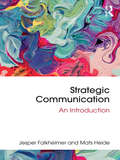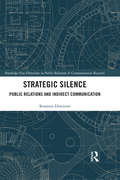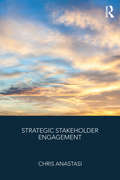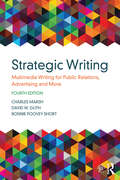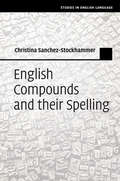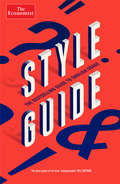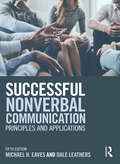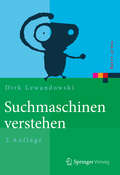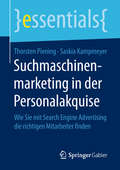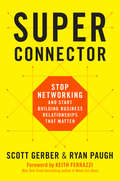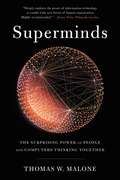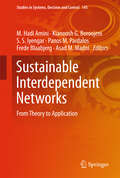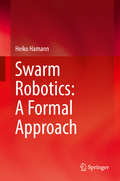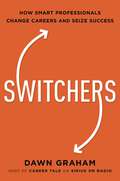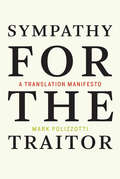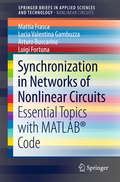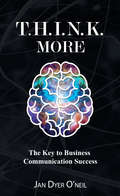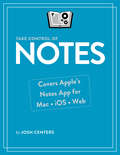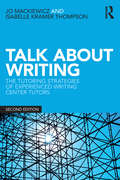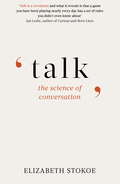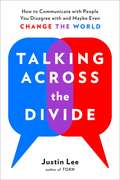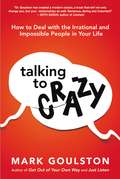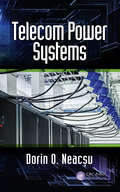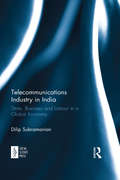- Table View
- List View
Strategic Communication: An Introduction (Routledge New Directions in Public Relations and Communication Research)
by Jesper Falkheimer Mats HeideStrategic communication comprises different forms of goal-oriented communication inside and between organizations, their stakeholders and the society. Strategic communication is an emerging practice and research field integrating established disciplines such as public relations, organizational communication and marketing communication into a holistic framework. The field is based on an awareness of the fundamental importance of communication for the existence and performance of all organizations. This textbook offers a broad insight into the field of strategic communication. The main aim of the book is to give a general overview of theories, concepts and methods in strategic communication. The book also aims to develop an understanding of different perspectives and the consequences each one has for practice. After reading the book the student or reader will be able to define and reflect upon strategic communication as an academic field and professional practice, describe relevant theories and apply these to communication problems. The authors apply a reflective and practice-oriented approach meaning earlier research or theories are not only described, but also discussed from different critical perspectives. A practice-oriented approach means, in this book, that the authors strongly emphasize the role of contexts and situations—where strategic communication actually happens. This book will help business and communications students to not only define and understand a variety of strategic communications theories, but to use those theories to generate communication strategy and solutions.
Strategic Silence: Public Relations and Indirect Communication (Routledge New Directions in PR & Communication Research)
by Roumen DimitrovMainstream public relations overvalues noise, sound and voice in public communication. But how can we explain that while practitioners use silence on a daily basis, academics have widely remained quiet on the subject? Why is silence habitually famed as inherently bad and unethical? Silence is neither separate from nor the opposite of communication. The inclusion of silence on a par with speech and non-verbal means is a vital element of any communication strategy; it opens it up for a new, complex and more reflective understanding of strategic silence as indirect communication. Drawing on a number of disciplines that see in silence what public relations academics have not yet, this book reveals forms of silence to inform public relations solutions in practice and theory. How do we manage silence? How can strategic silence increase the capacity of public relations as a change agent? Using a format of multiple short chapters and practice examples, this is the first book that discusses the concept of strategic silence, and its consequences for PR theory and practice. Applying silence to communication cases and issues in global societies, it will be of interest to scholars and researchers in public relations, strategic communications and communication studies.
Strategic Stakeholder Engagement: A Voice Behind The Curtain
by Chris AnastasiIs it your objective to bring about positive change for your business or organisation by influencing the policy and regulatory environment in which you operate? Do you need to know how to engage with decision-makers in government and other key influencers? Are you looking to pursue or advance your career in Public Relations? Ambitious practitioners working within Public Relations and Corporate Social Responsibility, inside or outside government respectively, and in private or non-profit organisations, will find this an invaluable guide.Revealing insights into the inner workings of government and drawing on real-life case studies, this book offers practical, clear, creative ideas and innovative strategies designed to empower Public Relations professionals to engage with key stakeholders effectively and to influence government policy and regulation. At a time of considerable uncertainty and ever-evolving government policy and regulation, this book shows how it is possible for businesses and organisations to have a voice and make an impact. Chris Anastasi, a recognised authority in Public Relations, has helped national and global organisations influence government and effect major change. He now offers Public Relations practitioners an unmissable chance to become even more effective influencers through his book. Strategic Stakeholder Engagement is essential high-quality reading for anyone involved in public relations, government affairs, lobbying and social responsibility activities in countries around the world.
Strategic Writing: Multimedia Writing for Public Relations, Advertising and More
by Charles Marsh David W. Guth Bonnie Poovey ShortIn its fourth edition, Strategic Writing emphasizes the goal-oriented mission of high-quality public relations and media writing with clear, concise instructions for more than 40 types of documents. This multidisciplinary text covers writing for public relations, advertising, sales and marketing, and business communication. In addition, it includes concise chapters on topics such as diversity, ethics and the legal aspects of strategic writing. Featuring a spiral binding, examples for each document and a user-friendly "recipe" approach, Strategic Writing is ideal for undergraduate PR or advertising writing classes that take an interdisciplinary approach. This new edition devotes new attention throughout to social media and writing in the digital realm, and features new and updated online resources for students and instructors.
Studies in English Language: English Compounds and Their Spelling (Studies in English Language)
by Christina Sanchez-StockhammerAnyone writing texts in English is constantly faced with the unavoidable question whether to use open spelling (drinking fountain), hyphenation (far-off) or solid spelling (airport) for individual compounds. While some compounds commonly occur with alternative spellings, others show a very clear bias for one form. This book tests more than sixty hypotheses and explores the patterns underlying the spelling of English compounds from a variety of perspectives. Based on a sample of 600 biconstituent compounds with identical spelling in all reference works in which they occur (200 each with open, hyphenated and solid spelling), this empirical study analyses large amounts of data from corpora and dictionaries and concludes that the spelling of English compounds is not chaotic but actually correlates with a large number of statistically significant variables. An easily applicable decision tree is derived from the data and an innovative multidimensional prototype model is suggested to account for the results.
Style Guide (Economist Books)
by The EconomistThis expanded twelfth edition of the bestselling guide to style is based on The Economist's own updated house style manual, and is an invaluable companion for everyone who wants to communicate with the clarity, style and precision for which The Economist is renowned.As the introduction says, 'clarity of writing usually follows clarity of thought.'The Economist Style Guide gives general advice on writing, points out common errors and clichés, offers guidance on consistent use of punctuation, abbreviations and capital letters and contains an exhaustive range of reference material--covering everything from accountancy ratios and stock market indices to laws of nature and science.Some of the numerous useful rules and common mistakes pointed out in the guide include:Which informs, that defines. This is the house that Jack built. But: This house, which Jack built, is now falling down.Discreet means circumspect or prudent; discrete means separate or distinct. Remember that "Questions are never indiscreet. Answers sometimes are" (Oscar Wilde).Flaunt means display, flout means disdain. If you flout this distinction you will flaunt your ignorance.Forgo means do without; forego means go before.Fortuitous means accidental, not fortunate or well-timed.Times: Take care. Three times more than X is four times as much as X.Full stops: Use plenty. They keep sentences short. This helps the reader.
Successful Nonverbal Communication: Principles and Applications
by Michael Eaves Dale G. LeathersSuccessful Nonverbal Communication: Principles and Applications demonstrates how knowledge of nonverbal messages can affect successful communication in the real world. Now with fifteen chapters, the fifth edition draws students in through applications of the latest nonverbal communication research and through current examples of celebrities, sports, and politicians. This extensive revision describes nonverbal cues and their desirable and undesirable functions while offering original tests for measuring and developing nonverbal communication skills. Updates include new attention to Donald Trump, Hillary Clinton, and Barack Obama, and discussion of nonverbal communication within same-sex partnerships.
Suchmaschinen verstehen (Xpert. Press Ser.)
by Dirk LewandowskiSuchmaschinen sind heute die wichtigsten Werkzeuge, um an Informationen zu gelangen. Wir verwenden Suchmaschinen täglich, meist ohne weiter darüber nachzudenken. Doch wie funktionieren diese Suchwerkzeuge eigentlich genau? Das Buch betrachtet Suchmaschinen aus vier Perspektiven: Technik, Nutzung, Recherche und gesellschaftliche Bedeutung. Es bietet eine klar strukturierte und verständliche Einführung in die Thematik. Zahlreiche Abbildungen erlauben eine schnelle Erfassung des Stoffs.Neben einer ausführlichen Darstellung der in den bekannten Suchmaschinen verwendeten Rankingverfahren wird auch ausführlich auf das Nutzerverhalten eingegangen, das wiederum die Ergebnisdarstellung prägt. Dazu kommen grundlegende Betrachtungen des Suchmaschinenmarktes, der Bedeutung der Suchmaschinenoptimierung und der Rolle der Suchmaschinen als technische Informationsvermittler. Das Buch richtet sich an alle, die mit Suchmaschinen zu tun haben und ein umfassendes Verständnis dieser Suchwerkzeuge erlangen wollen, u.a. Suchmaschinenoptimierer, Entwickler, Informationswissenschaftler, Bibliothekare, Rechercheure in Wissenschaft und Praxis sowie Online-Marketing-Verantwortliche.Für die zweite Auflage wurde der Text vollständig überarbeitet. Neben einem neuen Kapitel zur Suchmaschinenwerbung wurden zahlreiche Abschnitte zu neu aufgekommenen Themen hinzugefügt. Alle Statistiken und Quellen wurden auf den neuesten Stand gebracht.Aus Rezensionen zur ersten Auflage:„Dirk Lewandowski bringt den Fachleuten und Laien näher, was im Hintergrund der Suchmaschine abläuft und wie die Suchergebnisse zustande kommen.“ (Stephan Holländer in Password) „Dirk Lewandowski [...] hat einerseits das Fachwissen, sowohl in die Tiefe zu gehen als auch die Zusammenhänge so verständlich wie möglich zu behandeln. Ein Glücksfall!“ (Jürgen Plieninger in BuB)
Suchmaschinenmarketing in der Personalakquise: Wie Sie mit Search Engine Advertising die richtigen Mitarbeiter finden (essentials)
by Thorsten Piening Saskia KampmeyerThorsten Piening und Saskia Kampmeyer zeigen in diesem essential kompakt und auf den Punkt gebracht, wie Unternehmen im Internet neue Mitarbeiter gewinnen und insbesondere Search Engine Advertising (SEA) zielführend dafür nutzen können. Die Autoren erklären, wie Google und Co. die Candidate Journey effektiv unterstützen können und wie wichtig das kontinuierliche Monitoring mit allen Kennzahlen ist. Angereichert ist das essential mit zahlreichen praktischen Beispielen und konkreten Handlungsempfehlungen.
Superconnector: Stop Networking And Start Building Business Relationships That Matter
by Scott Gerber Ryan PaughAbandon the networking-for-networking's-sake mentality in favor of a more powerful and effective approach to creating and enhancing connections.STOP NETWORKING. Seriously, stop doing it. Now. It is time to ditch the old networking-for networking's-sake mentality in favor of a more powerful and effective approach to creating and enhancing connections. In Superconnector, Scott Gerber and Ryan Paugh reveal a new category of professionals born out of the social media era: highly valuable community-builders who make things happen through their keen understanding and utilization of social capital. Superconnectors understand the power of relationship-building, problem-solve by connecting the dots at high levels, and purposefully cause different worlds and communities to interact with the intention of creating mutual value.How can you become a Superconnector? Gerber and Paugh share instructive anecdotes from a who's who roster of high achievers, revealing how to systematically manage a professional community and maximize its value. Of utmost importance is practicing Habitual Generosity, acting on the knowledge that your greatest returns come when you least expect them, and that by putting others' needs first the good karma will flow back to you tenfold. Gerber and Paugh also explore winning strategies such as The Art of Selectivity, a well-honed ability to define which relationships matter most for you and decide how you will maintain them over time. Full of helpful advice on how to communicate with anyone about anything, Google-proof your reputation, and much more, Superconnector is a must-read for those seeking personal and business success.
Superminds: The Surprising Power of People and Computers Thinking Together
by Thomas W. MaloneFrom the founding director of the MIT Center for Collective Intelligence comes a fascinating look at the remarkable capacity for intelligence exhibited by groups of people and computers working together. If you're like most people, you probably believe that humans are the most intelligent animals on our planet. But there's another kind of entity that can be far smarter: groups of people. In this groundbreaking book, Thomas Malone, the founding director of the MIT Center for Collective Intelligence, shows how groups of people working together in superminds -- like hierarchies, markets, democracies, and communities -- have been responsible for almost all human achievements in business, government, science, and beyond. And these collectively intelligent human groups are about to get much smarter. Using dozens of striking examples and case studies, Malone shows how computers can help create more intelligent superminds simply by connecting humans to one another in a variety of rich, new ways. And although it will probably happen more gradually than many people expect, artificially intelligent computers will amplify the power of these superminds by doing increasingly complex kinds of thinking. Together, these changes will have far-reaching implications for everything from the way we buy groceries and plan business strategies to how we respond to climate change, and even for democracy itself. By understanding how these collectively intelligent groups work, we can learn how to harness their genius to achieve our human goals. Drawing on cutting-edge science and insights from a remarkable range of disciplines, Superminds articulates a bold -- and utterly fascinating -- picture of the future that will change the ways you work and live, both with other people and with computers.
Sustainable Interdependent Networks: From Theory To Application (Studies In Systems, Decision And Control #145)
by Panos M. Pardalos Frede Blaabjerg Kianoosh G. Boroojeni M. Hadi Amini S. S. Iyengar Asad M. MadniThis book focuses on the theory and application of interdependent networks. The contributors consider the influential networks including power and energy networks, transportation networks, and social networks. The first part of the book provides the next generation sustainability framework as well as a comprehensive introduction of smart cities with special emphasis on energy, communication, data analytics and transportation. The second part offers solutions to performance and security challenges of developing interdependent networks in terms of networked control systems, scalable computation platforms, and dynamic social networks. The third part examines the role of electric vehicles in the future of sustainable interdependent networks. The fourth and last part of this volume addresses the promises of control and management techniques for the future power grids.
Swarm Robotics: A Formal Approach
by Heiko HamannThis book provides an introduction to Swarm Robotics, which is the application of methods from swarm intelligence to robotics. It goes on to present methods that allow readers to understand how to design large-scale robot systems by going through many example scenarios on topics such as aggregation, coordinated motion (flocking), task allocation, self-assembly, collective construction, and environmental monitoring. The author explains the methodology behind building multiple, simple robots and how the complexity emerges from the multiple interactions between these robots such that they are able to solve difficult tasks. The book can be used as a short textbook for specialized courses or as an introduction to Swarm Robotics for graduate students, researchers, and professionals who want a concise introduction to the field.
Switchers: How Smart Professionals Change Careers - and Seize Success
by Dr. Dawn GrahamAre you stuck in an unsatisfying job or feel like you&’re in the wrong profession? An industry that just isn&’t a fit? Don&’t just settle but succeed in the right career!Get unstuck and land a new career—one you&’re genuinely passionate about. Switchers helps you realize that dream. Written by celebrated career coach and psychologist Dr. Dawn Graham, the book provides proven strategies that will get you where you want to go.The first step is to recognize that the usual rules and job search tools won&’t work for you. Resumes and job boards were designed with traditional applicants in mind. As a career switcher, you have to go beyond the basics, using tactics tailor-made to ensure your candidacy stands out.In Switchers, Dr. Graham reveals how to:Understand the concerns of hiring managersCraft a resume that catches their attention within six secondsSpotlight transferable skills that companies covetRebrand yourself—aligning your professional identity with your new aspirationsReach decision-makers by recruiting &“ambassadors&” from within your networkNail interviews by turning tough questions to your advantageConvince skeptical employers to shelve their assumptions and take a chance on youNegotiate a competitive salary and benefits packagePacked with psychological insights, practical exercises, and inspiring success stories, Switchers helps you leap over obstacles and into a whole new field. This guide will help you pull off the most daring—and fulfilling—career move of your life!
Sympathy for the Traitor: A Translation Manifesto (The\mit Press Ser.)
by Mark PolizzottiAn engaging and unabashedly opinionated examination of what translation is and isn't.For some, translation is the poor cousin of literature, a necessary evil if not an outright travesty—summed up by the old Italian play on words, traduttore, traditore (translator, traitor). For others, translation is the royal road to cross-cultural understanding and literary enrichment. In this nuanced and provocative study, Mark Polizzotti attempts to reframe the debate along more fruitful lines. Eschewing both these easy polarities and the increasingly abstract discourse of translation theory, he brings the main questions into clearer focus: What is the ultimate goal of a translation? What does it mean to label a rendering “faithful”? (Faithful to what?) Is something inevitably lost in translation, and can something also be gained? Does translation matter, and if so, why? Unashamedly opinionated, both a manual and a manifesto, his book invites usto sympathize with the translator not as a “traitor” but as the author's creative partner.Polizzotti, himself a translator of authors from Patrick Modiano to Gustave Flaubert, explores what translation is and what it isn't, and how it does or doesn't work. Translation, he writes, “skirts the boundaries between art and craft, originality and replication, altruism and commerce, genius and hack work.” In Sympathy for the Traitor, he shows us how to read not only translations but also the act of translation itself, treating it not as a problem to be solved but as an achievement to be celebrated—something, as Goethe put it, “impossible, necessary, and important.”
Synchronization in Networks of Nonlinear Circuits: Essential Topics With Matlab® Code (SpringerBriefs in Applied Sciences and Technology)
by Luigi Fortuna Arturo Buscarino Mattia Frasca Lucia Valentina GambuzzaThis book addresses synchronization in networks of coupled systems. It illustrates the main aspects of the phenomenon through concise theoretical results and code, allowing readers to reproduce them and encouraging readers to pursue their own experimentation. The book begins by introducing the mathematical representation of nonlinear circuits and the code for their simulation. This is followed by a brief account of the concept of the complex network, which describes the main aspects of complex networks and the main model types, with a particular focus on the code used to study and reproduce the models. The focus then shifts to the process through which independent nonlinear circuits that follow different trajectories without coupling share some properties of their motion: synchronization. The authors present the main techniques for studying synchronization in complex networks, including the major measures, the stability properties and control techniques. The book then moves on to advanced topics in synchronization of complex networks by examining forms of synchronization in which not all the units share the same trajectory, namely chimera states, clustering synchronization, and relay and remote synchronization. Simple codes for experimentation with these topics and control methods are also provided. In closing, the book addresses the problem of synchronization in time-varying networks.
T.H.I.N.K. More: The Key to Business Communication Success
by Jan Dyer O'NeilThe must-have business book. Underneath your polished exterior is a challenged caveperson fending off the mammoth beast of technology every day. Defend yourself by fueling your mind with smart communication concepts, many of which are powered by research in neuroscience and psychology. You'll discover T.H.I.N.K. isn't a stiff ho-hum rules book—it’s the Elements of Style guide for communication success. You’ll learn:Why we are drawn to technology and how to manage itHow to reduce your screen time and be more productive Think, create, and brainstorm wisely and often Experience positive communication Get the messages you want, send the messages they want Write to capture your reader’s attention and keep itT.H.I.N.K. is a must-have business book for every busy, business professional. Good news! You don’t have to T.H.I.N.K. alone! Use this resourceful guide to create a communications plan with your team and experience the benefits of partying working like it’s 1999!
Take Control of Notes
by Josh CentersUnlock the potential of Apple's Notes app! Apple's Notes has come a long way since it was first introduced with the iPhone as a simple note-taking app, but many users are still unaware of its expanded capabilities. Now available on Macs, iOS devices, and on the web at iCloud.com, Notes has become a surprisingly powerful tool for writing, sketching, organizing, and sharing information of all kinds. In Take Control of Notes, TidBITS Managing Editor Josh Centers provides a quick but thorough guide to this deceptively simple app, showing you how to master its many tools--and avoid or work around its limitations. Among many other things, you'll learn how to: Choose where to stores notes (iCloud, IMAP, or a device) and whether or how they sync Import notes from other apps and services Apply and modify character-level and paragraph-level formatting in a note Make lists (including checklists and lists with multiple levels of indentation) Work with tables in notes Encrypt notes with a password Add photos, videos, audio, maps, and other content to your notes Scan printed documents into Notes and save them as PDF attachments Draw and sketch using your finger or an Apple Pencil Share notes with other users Organize your notes into folders and search their contents
Talk about Writing: The Tutoring Strategies of Experienced Writing Center Tutors
by Jo Mackiewicz Isabelle ThompsonTalk about Writing: The Tutoring Strategies of Experienced Writing Center Tutors offers a book-length empirical study of the discourse between experienced tutors and student writers in satisfactory conferences. It analyzes writing center talk, focusing on tutors’ verbal strategies, at the macro- and microlevels. The study details tutors’ use of three categories of tutoring strategies—instruction, cognitive scaffolding, and motivational scaffolding—with each chapter of the analysis ending in practical advice about tutor training. The second edition adds to the discussion of research provided in the first edition, maintaining the two previous goals: to provide a theory-based coding scheme for analyzing tutoring strategies according to their potential for instructing and scaffolding student writers’ learning, and to demonstrate that analysis on 10 satisfactory conferences conducted by experienced writing center tutors. New to this edition, the authors expand the previous discussion of the coding scheme with additional details about its development. Along with the expanded Chapter 3 about research methods, this edition features new examples from the corpus of conferences and updates the literature review.
Talk: The Science of Conversation
by Elizabeth StokoeWe spend much of our days talking. Yet we know little about the conversational engine that drives our everyday lives. We are pushed and pulled around by language far more than we realize, yet are seduced by stereotypes and myths about communication.This book will change the way you think about talk. It will explain the big pay-offs to understanding conversation scientifically. Elizabeth Stokoe, a social psychologist, has spent over twenty years collecting and analysing real conversations across settings as varied as first dates, crisis negotiation, sales encounters and medical communication. This book describes some of the findings of her own research, and that of other conversation analysts around the world. Through numerous examples from real interactions between friends, partners, colleagues, police officers, mediators, doctors and many others, you will learn that some of what you think you know about talk is wrong. But you will also uncover fresh insights about how to have better conversations - using the evidence from fifty years of research about the science of talk.
Talk: The Science of Conversation
by Elizabeth StokoeWe spend much of our days talking. Yet we know little about the conversational engine that drives our everyday lives. We are pushed and pulled around by language far more than we realize, yet are seduced by stereotypes and myths about communication.This book will change the way you think about talk. It will explain the big pay-offs to understanding conversation scientifically. Elizabeth Stokoe, a social psychologist, has spent over twenty years collecting and analysing real conversations across settings as varied as first dates, crisis negotiation, sales encounters and medical communication. This book describes some of the findings of her own research, and that of other conversation analysts around the world. Through numerous examples from real interactions between friends, partners, colleagues, police officers, mediators, doctors and many others, you will learn that some of what you think you know about talk is wrong. But you will also uncover fresh insights about how to have better conversations - using the evidence from fifty years of research about the science of talk.
Talking Across the Divide: How to Communicate with People You Disagree with and Maybe Even Change the World
by Justin LeeA guide to learning how to communicate with people who have diametrically opposed opinions from you, how to empathize with them, and how to (possibly) change their mindsAmerica is more polarized than ever. Whether the issue is Donald Trump, healthcare, abortion, gun control, breastfeeding, or even DC vs Marvel, it feels like you can't voice an opinion without ruffling someone's feathers. In today's digital age, it's easier than ever to build walls around yourself. You fill up your Twitter feed with voices that are angry about the same issues and believe as you believe. Before long, you're isolated in your own personalized echo chamber. And if you ever encounter someone outside of your bubble, you don't understand how the arguments that resonate so well with your peers can't get through to anyone else. In a time when every conversation quickly becomes a battlefield, it's up to us to learn how to talk to each other again. In Talking Across the Divide, social justice activist Justin Lee explains how to break through the five key barriers that make people resist differing opinions. With a combination of psychological research, pop-culture references, and anecdotes from Justin's many years of experience mediating contentious conversations, this book will help you understand people on the other side of the argument and give you the tools you need to change their minds--even if they've fallen for "fake news."
Talking to 'Crazy': How to Deal with the Irrational and Impossible People in Your Life
by Marshall Goldsmith Mark Goulston“[Goulston’s]ideas are a bit counter-intuitive but they really do shift the dynamic and help people diffuse and disarm the irrational person leading to more positive outcomes.” -- Online MBA Because some people are beyond difficult… Let’s face it, we all know people who are irrational. No matter how hard you try to reason with them, it never works. So what’s the solution? How do you talk to someone who’s out of control? What can you do with a boss who bullies, a spouse who yells, or a friend who frequently bursts into tears? In his book, Just Listen, Mark Goulston shared his bestselling formula for getting through to the resistant people in your life. Now, in his breakthrough new book Talking to Crazy, he brings his communication magic to the most difficult group of all—the downright irrational. As a psychiatrist, Goulston has seen his share of crazy and he knows from experience that you can’t simply argue it away. The key to handling irrational people is to learn to lean into the crazy—to empathize with it. That radically changes the dynamic and transforms you from a threat into an ally. Talking to Crazy explains this counterintuitive Sanity Cycle and reveals: Why people act the way they do • How instinctive responses can exacerbate the situation—and what to do instead • When to confront a problem and when to walk away • How to use a range of proven techniques including Time Travel, the Fish-bowl, and the Belly Roll • And much more You can’t reason with unreasonable people—but you can reach them. This powerful and practical book shows you how.
Telecom Power Systems
by Dorin O. NeacșuThis book addresses topics specific to the application of power electronics to telecom systems. It follows the power flow from national grid down to the last low-voltage high current requirement of a processor. Auxiliary equipment requirements, such as uninterruptible power supplies, storage energy systems, or charging systems, are explained, along with peculiar classification or suggestions for usage. The presentation of each telecom power system is completed with a large number of practical examples to reinforce new material.
Telecommunications Industry in India: State, Business and Labour in a Global Economy
by Dilip SubramanianTelecommunications Industry in India represents the first comprehensive study of a state-run enterprise in the telecommunications industry. The study traces over a period of half a century (1948-2009) the growth and decline of Indian Telephone Industries (ITI). At the heart of the monograph stands one central interrogation: How does the socio-technical system of production in a state-controlled firm shape the relations linking the four main actors: the state, management, union and workers? The original contribution of this book lies in combining business history and labour history within a single conceptual framework. The author evaluates the broader conclusions about the telecommunications industry and public sector through the lens of an individual firm to arrive at a more nuanced understanding of the dynamics of change in the globalizing Indian economy. The work is well in command of the literature on the global business history counterparts of ITI in the telecommunications industry. It is further strengthened by the use of French material on the subject which is now accessible for the first time in English. Please note: Taylor & Francis does not sell or distribute the Hardback in India, Pakistan, Nepal, Bhutan, Bangladesh and Sri Lanka
